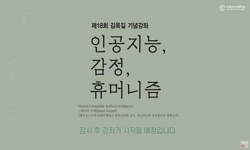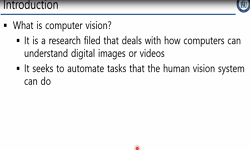최근 상용화되고 있는 컴퓨터 비전 기술이 새로운 쟁점들을 제기하고 있는 현실에 주목하여 본 논문은 인간중심주의에 국한되어왔던 시각성 담론을 비인간 존재자인 인공지능을 포함하 는 ...
http://chineseinput.net/에서 pinyin(병음)방식으로 중국어를 변환할 수 있습니다.
변환된 중국어를 복사하여 사용하시면 됩니다.
- 中文 을 입력하시려면 zhongwen을 입력하시고 space를누르시면됩니다.
- 北京 을 입력하시려면 beijing을 입력하시고 space를 누르시면 됩니다.

컴퓨터 비전과 시각성의 확장- 동시대 예술작품들을 중심으로 = Computer Vision and Expansion of Visuality: focusing on Contemporary Artworks
한글로보기부가정보
국문 초록 (Abstract)
최근 상용화되고 있는 컴퓨터 비전 기술이 새로운 쟁점들을 제기하고 있는 현실에 주목하여 본 논문은 인간중심주의에 국한되어왔던 시각성 담론을 비인간 존재자인 인공지능을 포함하 는 방향으로 확장시킬 수 있는 가능성을 모색한다. 이를 위해 본 논문은 티모시 모턴의 ‘번역’ 개념과 캐서린 헤일스의 ‘인지적 집합’ 개념을 참조하여 동시대 예술작품들이 어떤 시각성 변 화를 보여주는지를 추적한다. 포렌식 아키텍처의 <트리플 체이서>는 모턴의 제안을 참조하여 시각을 사물의 자족성을 보증하는 감각이 아니라 객체를 변화시키는 ‘원격작용’으로 보게 만 드는 작품으로 해석된다. 트레버 페글렌의 <이미지 연산 op.10>은 인간의 시각과 컴퓨터 비전 의 상호번역을 보여주는 사례로 해석된다. 이 작품의 이미지들이 인간이 본 것인지 인공지능이 본 것인지 모호하다는 점은 모턴적 의미에서 객체가 외양으로 환원되지 않는다는 점을 보여주 는 긍정적 특성으로 해석된다. 제인 & 루이즈 윌슨의 <얼굴 스크립팅: 그 건물은 무엇을 보았 는가?>는 헤일스의 인지적 집합 및 포스트휴먼 개념을 참조하여 개체를 넘어서는 ‘편재하는 시 선’의 문제를 제기하는 것으로 해석된다.
다국어 초록 (Multilingual Abstract)
This paper tracks the changes in contemporary notions of visuality and seeks to expand the discourse on visuality, traditionally centered around anthropocentrism, to include non-human entities like artificial intelligence, witnessing the on-going issu...
This paper tracks the changes in contemporary notions of visuality and seeks to expand the discourse on visuality, traditionally centered around anthropocentrism, to include non-human entities like artificial intelligence, witnessing the on-going issues raised by the emergence of computer vision technologies. In doing so, it draws on the theories of Timothy Morton and N. Katherine Hayles, particularly the concepts of ‘translation’ and ‘cognitive assemblage.’ The Forensic Architecture’s Triple Chaser is interpreted as a work that, referring to Morton’s suggestions, redefines vision not as a sense that guarantees the self-sufficiency of objects but as a ‘remote action’ that transforms objects. Trevor Paglen’s Image Operations Op. 10 is analyzed as a case showing the mutual translation between human vision and computer vision. The ambiguity of whether the images in this work are seen by humans or AI is interpreted as a positive feature that demonstrates, in Mortonian terms, that objects cannot be reduced to mere appearance. Jane & Louise Wilson’s Face Scripting: What Did the Building See? is analyzed as a work that, referencing Hayles’ concepts of ‘cognitive assemblage’ and ‘posthuman’, raises the issue of the ‘ubiquitous gaze’ that transcends individual entities.
동일학술지(권/호) 다른 논문
-
암호화폐를 통한 공동체에 나타나는 무위의 공동체적 요소 연구
- 현대미술학회
- 유가은
- 2024
- KCI등재
-
사진 미학에 나타난 바니타스 알레고리 연구-볼프강 틸만스의 《정물 Still Life》 연작을 중심으로
- 현대미술학회
- 황선영
- 2024
- KCI등재
-
반성하는 신체, 탈존의 예술: 메를로-퐁티의 신체론이 여는 포스트휴머니즘의 새지평
- 현대미술학회
- 김민정
- 2024
- KCI등재
-
- 현대미술학회
- 조주연
- 2024
- KCI등재
분석정보
연관 공개강의(KOCW)
-

[제18회 김옥길기념강좌] 인공지능, 감정, 휴머니즘(Human-Compatible Artificial Intelligence’)’
이화여자대학교 스튜어드 러셀 -

누구나 할 수 있는 데이터 분석과 인공지능[Data Analysis and Artificial Intelligence for Everyone]
K-MOOC 인하공업전문대학 이세훈 -

누구나 할 수 있는 데이터 분석과 인공지능[Data Analysis and Artificial Intelligence for Everyone]
K-MOOC 인하공업전문대학 이세훈 -

컴퓨터비전
한동대학교 황성수 -

파이썬을 이용한 컴퓨터비전 프로그래밍
금오공과대학교 이해연




 DBpia
DBpia

